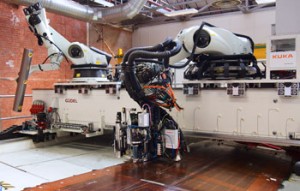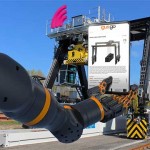Robots show how to boost aero assembly operations
 KUKA is playing a key role in the development of an innovative automated system for assembling complex aircraft structures in collaboration with Europe’s leading airplane manufacturer. The automation specialist has devised a flexible robotic solution for performing a variety of drilling and fastening tasks on the upper and lower wing covers of a lateral wing box demonstration unit being built at the Airbus facility in Filton.
KUKA is playing a key role in the development of an innovative automated system for assembling complex aircraft structures in collaboration with Europe’s leading airplane manufacturer. The automation specialist has devised a flexible robotic solution for performing a variety of drilling and fastening tasks on the upper and lower wing covers of a lateral wing box demonstration unit being built at the Airbus facility in Filton.
The wing box is due to be delivered to Toulouse this summer where it will undergo a series of rigorous structural tests. The results will then be evaluated by Airbus to see if the new robotic technology is suitable for use in current as well as future aircraft programmes. KUKA’s collaboration with Airbus is part of the Advanced Low Cost Aircraft Structures (ALCAS) project, a €100m EC-backed research scheme that aims to identify new composite manufacturing and assembly strategies. Airbus wanted to explore the development of a flexible, re-configurable solution that could undertake a number of tasks on a single system and offer a modular design so that other processes could be added in the future, explained Gary Taylor, KUKA’s UK aerospace manager.
One of the project’s main objectives was to improve efficiency by using a horizontal wing build philosophy instead of the conventional vertical manual method, a time-consuming and labour-intensive process. Thanks to KUKA’s expertise, an effective assembly system has been devised that incorporates a number of innovative new technologies such as KUKA’s 18 tonne payload OmniMove, a mobile positioning device that provides an alternative to using a crane for manoeuvring the carbon fibre wing covers into the jig. The OmniMove is also used to position a pair of platform-mounted KUKA robots for drilling holes in the lower wing cover.
The assembly system also includes an identical pair of robots installed on a high-level gantry for the upper wing cover operation. Two of the robots are equipped with an adaptive guidance device for monitoring the accuracy of the drill head position while the others feature a multi-function end effector specially designed to drill holes ranging in diameter from 6-22mm and a material thickness of up to 110mm. The design of the robot end effector is another example of new technology specifically developed for the project by KUKA. It not only offers a choice of spindle systems for axial and orbital drilling capabilities, but also other integrated features such as a fastener insertion facility and non-contact optical measurement probe.
Visit the KUKA website for more information.
See all stories from KUKA















